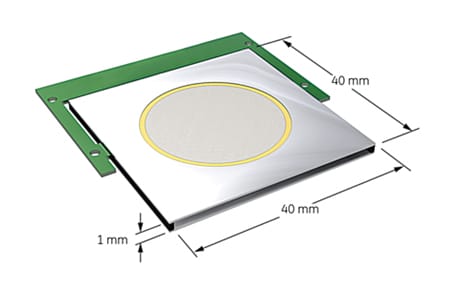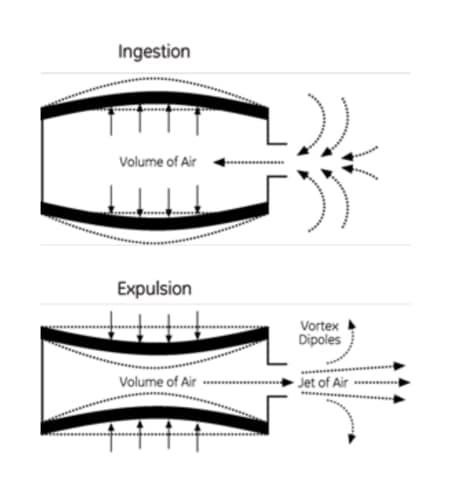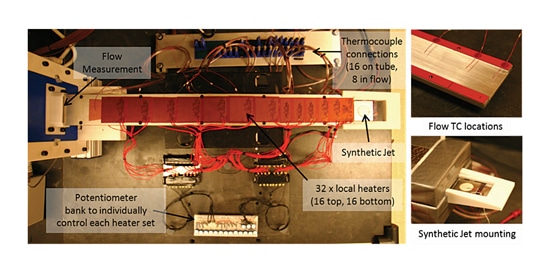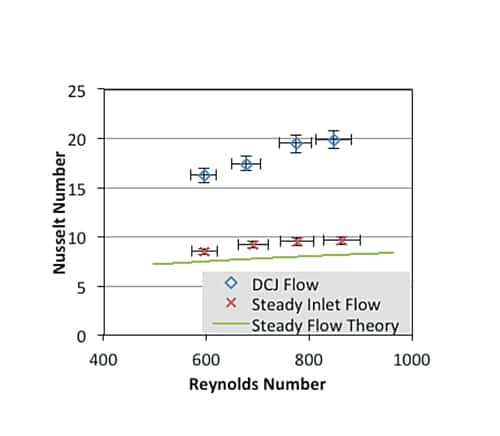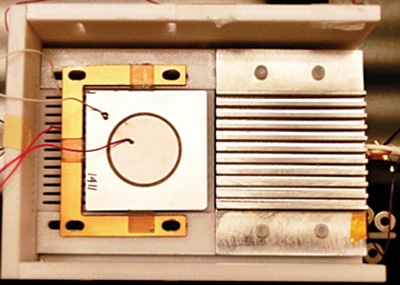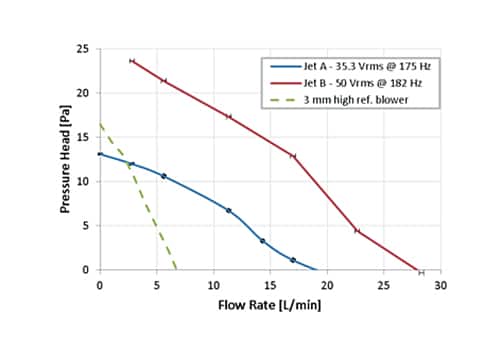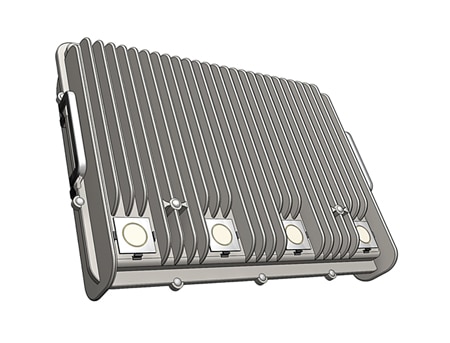Introduction
Modern portable consumer electronics devices such as ultrabooks, tablets and smartphones are easily recognized for the incredible functionality they offer in very compact packages. Due to advances in semiconductor miniaturization and the development of dual and quad-core architectures, current and next-generation portable devices boost computational and graphics performance capabilities that can outpace former generations desktop computers. Besides logic chips, these platforms can also host an array of other technologies such as storage systems, advanced batteries, touch-screen input and backlight systems. As this rapidly changing landscape of portable devices evolves, a common challenge becomes apparent: How to manage the heat rejection from thin consumer electronics with increasingly higher power dissipation requirements in thin profile devices. Where ultrabooks are commonly vented, tablets and smartphones predominantly rely on passive heat dissipation mechanisms. Recent evaluation of next generation tablets found that when devices are in full-use, their case temperature can become quite hot, reaching operator handling limits[1]. As next generation tablets with more powerful processors are under evaluation for advanced operating systems[2], thermal management is likely to become critical enough for even air cooling vents to find their introduction into select high power tablets[3]. Significant manufacturing and aerodynamic challenges exist in reducing the dimensions of rotating air mover system components such as bearings or bushings to the sub 4 mm dimension required for modern device implementation[4]. This reflects the disparate trends in the two technology areas, whereby the electrical components have proven far more conducive to miniaturization than their mechanical counterparts. This drives a need for novel miniaturized air mover technologies that can provide air movement using different mechanisms to break this barrier. Technologies such as Ionic Wind[5,6] and Synthetic Jets[7,8] are therefore of interest to solve some of these challenges, each providing their own opportunities and challenges. This article will focus on the evaluation of Synthetic Jets.
Synthetic Jets
Gutmark et al. [9] pioneered use of micro fluidic devices for heat transfer for both natural and forced convection. These micro-fluidic devices were found to significantly perturb the thin boundary layer that naturally envelops a heated surface, hence significantly improving heat transfer. Gutmark found heat transfer coefficient enhancement over natural convection of up to four times. Synthetic jets are characterized by the ability to perturb the flow from a single orifice. From this, a variety of different synthetic jet architectures have been evaluated by different research teams. These variants are characterized by different actuation mechanisms (commonly piezoelectric or electromagnetic) and the number and configuration of actuated surfaces. These variants include Synthetic Jet systems integrated with heat sinks[11], Piezoelectric fan and/or rake systems[12,13] and thin planar synthetic jets, also known as Dual Piezoelectric Cooling Jets(DCJs)[7,8,14]. Each architecture has its unique challenges and advantages as well as application opportunities. This article will focus on a the latter version as originally pioneered by Garg, Weaver and Arik[14] for cooling of electronic components. This variant of a Synthetic Jet is characterized by a thin 1 mm profile where two disks are actuated with a piezoelectric element to rapidly ingest and expel air. One of the attractive features of this version of synthetic jets is that it expels air in-plane with the device at high velocity, providing a thin cooling solution. Typical operating frequencies are between 125Hz and 175Hz for the configuration shown in Figure 1.
Figure 1: Planar synthetic jet microfluidic device.
Figure 2: Device operation, (adapted from Arik et al. [15])
Synthetic jets are often characterized as zero net-mass-flux but positive net momentum devices[10]. This characterization holds when evaluating flow transport across the orifice boundary. However, recent studies[7,8,11] also discuss in detail how entrainment of flow leads to the ability to produce positive flow when a larger control volume is evaluated. As with any new technology, proper characterization and understanding of device operation is crucial for successful implementation. This document presents recent flow and heat transfer performance results, as well as discusses different application configurations.
Synthetic Jet Flow Characteristics
As illustrated in Figure 2, the flow generated by a synthetic jet is of different nature than that provided by conventional air movers. During the expulsion stage of the synthetic jet, high velocity flow is produced at the center of the opening. This high velocity flow entrains neighboring flow and vortices are formed. Although part of the flow can be re-ingested on the following in-stroke, the entrained air as well as part of the high momentum jet departs the device and a net flow is created. Understanding of these mechanisms is important as experimental studies [8] have demonstrated that an optimal distance from the device exist to achieve maximum net flow. Net flow is important as it is undesirable to ingest flow that is heated by downstream components. As the typical device operates at 100-175Hz, the ingestion-expulsion cycle is repeated many times a second. The unsteady nature of this flow structure aids in disrupting the boundary layer as is confirmed in observations by Valiorgue et al. [16].
Convective thermal management at the simplest level comes down to providing sufficient air flow as to limit sensible heat rise of the convective fluid and providing a high heat transfer coefficient over the hot component surface as to remove heat with minimal convective temperature rise. Due to the discussed nature of synthetic flow, they are effective in the latter. This is illustrated by evaluation of the Nusselt number, which scales typically linearly with the heat transfer coefficient. Mahalingam et al.[17] demonstrated Nusselt number enhancement of flow induced by a different kind of synthetic jet for Reynolds numbers in the range of 1500-3300.
An experimental evaluation was performed to study this effect for the specific thin planar synthetic jet configuration. For this experiment a 61 cm (2 feet) long rectangular tube with inner dimension of 42mm x 7mm (W x H) was instrumented with an array of resistive heaters and thermocouples with additional thermocouples centered in the flow path (Figure 3). Heaters and temperature measurements were spaced closer at the tube inlet to more accurately capture inlet effects.
Figure 3: Experimental configuration for Nusselt number evaluation (insulation removed for visible access).
After heat loss characterization and calibration, the synthetic jet was turned on to provide 21.2 l/min (0.75 CFM) of flow. Each heater was heated at an independent power level to achieve a constant temperature boundary condition, which required significant time and iterations due to the thermal lag of the system. The experiment was then performed by drawing the same exact 21.2 l/min flow rate through the system using an imposed pressure gradient (synthetic jet off), which will be referred to as the steady flow condition. This was repeated at different flow rates. For each case, the corrected heat input and temperature difference between flow and wall were evaluated to derive the Nusselt number as a function of distance in the tube. As anticipated, the Nusselt number, which scales inversely with boundary layer thickness, starts at a high value at the entrance and reduces to a constant value as the boundary layer develops. Results for the fully developed Nusselt number agree with theory[18] and show that the synthetic jet flow transitions into steady flow before exiting the duct (Figure 4).
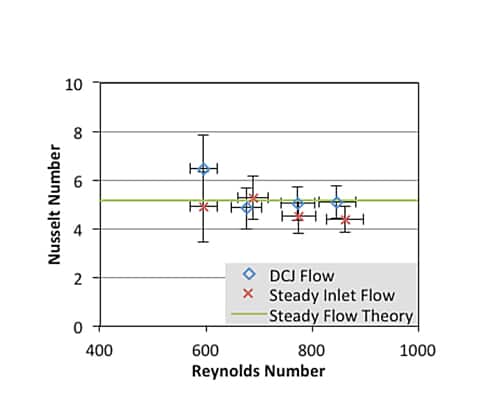
Figure 5: Nusselt number at entrance comparison (averaged over first 76 mm of tube).
In the entrance region, the unsteady flow from the synthetic jet provides significantly enhanced convection. For the same flow rate, the synthetic jets Nusselt number (averaged over the first 76 mm of the tube) is approximately twice as high as that of the steady flow(Figure 5). This confirms earlier findings from Mahalingam et al. and expands upon the conclusions for a different type of synthetic jet, and for a different Reynolds number range. This means that synthetic jet induced flow can provide up to 2X lower convective temperature rise than steady induced flows at the same flow rate due to the inherent flow characteristics.
Synthetic Jet application considerations
Typically air movers are placed in the back of laptops where they provide air flow over a compact miniaturized heat sink that connects the heat producing elements of the system by use of thin-profile heat pipes. For these types of systems, or perhaps future other portable electronics devices, thin planar synthetic jets could provide an attractive option. A variety of studies have investigated synthetic jet application configurations[15,19]. Recent studies [7] have demonstrated the ability for this type of synthetic jets to provide air flow in tightly enclosed spaces with a height limited to 4 mm (Figure 6). In addition, this work quantified the flow and pressure characteristics of a synthetic jet to be similar to comparable small blowers(Figure 7). The jet A device was able to provide a maximum pressure head of 13.1 Pa at zero flow and a maximum flow rate of 19 l/min at zero backpressure. Jet B was able to produce in excess of 24 Pa head at zero flow and 28 l/min flow at zero back pressure. AC power to the device in this experiment was provided by a DC to AC conversion circuit developed for the synthetic jets. Typical power consumption for the device is 200-350 mW depending on operating settings, which is a power consumption level comparable to the small blower evaluated in Figure 7.
Figure 6: Thin planar synthetic jet in 4 mm high covered enclosure demonstrated 2x cooling performance enhancement [7].
Figure 7: PQ-curve Jet A & Jet B measured data. 3 mm reference blower data from mfg. spec. [7,20].
The thin profile of the synthetic jet allows for a number of unique implementation configurations. For instance, because of the minimal height, it is conceivable to mount a device near electronics to directly move air over a hot component.
Figure 8: Potential application configurations for planar synthetic jets.
Figure 8 illustrates various configurations for the synthetic jet device to provide in-plane, impingement flow, or angled flow for cooling a specific electronic component. It is possible to use synthetic jets as the sole flow source or in combination with a bulk air flow provided by the system. There have been studies quantifying cooling enhancement provided by these devices in these configurations [7, 15].
Figure 9: Synthetic jets integrated with heat sink.
Other implementation configurations that can be considered include mounting of synthetic jets in-line with fin-structures embedded in heat sinks to augment convection as illustrated by Figure 9. In this configuration implementation of synthetic jets would reduce the total surface area slightly, but local fin structures can be adapted to reach optimized heat transfer performance.
Conclusion
Consumer electronics products are evolving rapidly to provide more powerful electronics in smaller, thin profile packages. As a result of this trend, new thermal management solutions are of interest that can provide effective cooling in a thin profile space. Fans and blowers have been traditionally the air mover mechanism of choice; however miniaturization of such systems poses significant challenges. Miniaturizations of bearings and DC motors to sub 4 mm dimensions is challenging due to finite machining tolerances. Novel convective air mover technologies such as Synthetic Jets augment the air mover space by providing air flow through flow entrainment. Multiple synthetic jet variants exist, each with their unique characteristics, challenges and advantages. The Synthetic jet version presented in this study is a thin form factor architecture that can provide a local high velocity jet of coolant in-plane with a hot component or device. As these new technologies mature, we learn more about the effective flow and heat transfer performance of these devices which is crucial to lead to future successful implementation. Nusselt number enhancement greater than 2X was experimentally validated over the first 76 mm of a constant temperature tube surface for these devices at low Reynolds numbers. Maximum entrained flow rates of 19 to 28 l/min, similar to small blowers, were experimentally evaluated. The expansion of air mover options beyond fans and blowers leads to new opportunities for solving the cooling challenges of tomorrow’s portable consumer and other electronic systems. Synthetic Jets have the potential to be part of that solution.
References
[1] D. L. Tapellini, Our test finds new iPad hits 116 degrees while running games, Consumer reports, 2012, http://news.consumerreports.org/electronics/2012/03/our-test-finds-new-ipad-hits-116-degrees-while-running-games.html
[2] A. Cunninham, Lenovo unveils new Atom-powered ThinkPad Tablet 2 with Windows 8, ArsTechnica, Aug 8 2012, http://arstechnica.com/gadgets/2012/08/lenovo-unveils-new-atom-powered-thinkpad-tablet-2-with-windows-8/
[3] S. Anthony, The answer to all our Windows 8 dreams: The Ivy Bridge Asus Transformer Book, ExtremeTech, June 4 2012, http://www.extremetech.com/computing/130364-the-answer-to-all-our-windows-8-dreams-the-ivy-bridge-asus-transformer-book
[4] Tien, X., Cooling Fan Reliability: Failure Criteria, Accelerated Life Testing, Modeling and Qualification, Annual Reliability and Maintainability Symposium, 2006, pp. 380-384, 2006
[5] Go, D.B., Garimella, S.V., Fisher, T.S., Mongia, R.K., 2007, Ionic Winds for Locally Enhanced Cooling, Journal of Applied Physics, Vol. 102, art. no. 053302.
[6] Tirumala, R, Go, D.B., 2012, Ionic Winds: A New Frontier for Air Cooling, Electronics Cooling Magazine, March 2012.
[7] H.P.J. de Bock, Chamarthy, P, et al. Investigation and application of an Advanced Dual Piezoelectric Cooling Jet, Proceedings of the intersociety conference on Thermal and Thermomechanical Phenomena, Itherm 2012, San Diego, CA, 2012.
[8] H.P.J. de Bock, Jackson, J.L., et al. Experimental Flow Performance Evaluation of novel miniaturized Advanced Piezoelectric Dual Cooling Jet, Proceedings of the intersociety conference on Thermal and Thermomechanical Phenomena, Eurotherm 2012, Poitiers, France, 2012.
[9] Gutmark, E., Yassour, Y., and Wolfshtein, M., Acoustic enhancement of heat transfer in plane channels, Proceedings of the Seventh International Heat Transfer Conference, Munich, Germany, pp. 441-445, 6-10 Sept. 1982.
[10] Smith, B. L., and Glezer, A., The Formation and Evolution of Synthetic Jets, Physics of Fluids, Vol.10.
[11] Mahalingam, R, Heffington, S, Jones, L, Williams, R, 2007, “Synthetic jets for forced air cooling of electronics”, Electronics Cooling Magazine, volume 13, no. 2, May 2007.
[12] S. M. Wait, S. Basak, S. V. Garimella, and A. Raman, “Piezoelectric fans using higher flexural modes for electronics cooling applications,” IEEE Trans. Compon. Packag. Technol., vol. 30, no. 1, pp. 119–128, Mar. 2007.
[13] Kimber, Mark; Suzuki, Kazuhiko; Kitsunai, Nobutaka; Seki, Kenichi; and Garimella, Suresh V., “Pressure and Flow Rate Performance of Piezoelectric Fans” (2010). CTRC Research Publications. Paper 146.
[14] Garg, J., Arik, M., Weaver, S., and Saddoughi, S., Micro fluidic jets for thermal management of electronics, Proc. ASME Heat Transfer/Fluids Engineering Summer Conference, Charlotte, North Carolina, FED F-346, July 11-15, 2004.
[15] Arik, M., Utturkar, Y., Interaction of a Synthetic Jet With an Actively Cooled Heat Sink, Proceedings of the intersociety conference on Thermal and Thermomechanical Phenomena, Itherm 2008, Orlando, Fl, 2008.
[16] P. Valiorgue, T. Persoons, A. McGuinn, and D. B. Murray, Heat transfer mechanisms in an impinging synthetic jet for a small jet-to-surface spacing, Experimental Thermal and Fluid Science, vol. 33, no. 4, pp. 597-603, 2009.
[17] Mahalingam, R., Rumigny, N., and Glezer, A., Thermal Management Using Synthetic Jet Ejectors, IEEE-CPMT Trans., 27, 3, Sept. 2004.
[18] Kays, W., and Crawford, M., Convective Heat and Mass Transfer. Third Edition. New York: McGraw-Hill, Inc., 1966. Page 125, 149-152.
[19] Beratlis, N, Smith, M.K., Optimization of synthetic jet cooling for microelectronics applications [VCSEL array example], SEMI-THERM 2003 proceedings, pp. 66-73, 2003
[20] http://www.sunonusa.com/pdf/mm_fan_catalog.pdf
Peter de Bock is a Lead Thermal Systems Engineer at GE Global Research in Niskayuna, N.Y. He has over 10 years experience in developing innovative thermal management solutions for electrical machines and electronics. He holds an MSME degree from Twente Technical University. His past experience includes CFD tool development, electrical machine cooling, thermoelectric system design and heat pipe/vapor chamber design and validation. His current work is focused on developing and characterization of next generation Dual Cool Jet air movers for electronics cooling. Peter is a member of K-16 committee on Heat Transfer in Electronic Equipment and an active ASME and IEEE reviewer.
Andrew Mann is an intern at GE GRC and will be returning to Stony Brook University to complete his M.S. in Mechanical Engineering. His work in GRC’s Electronic Cooling lab includes convection and conduction heat transfer analysis and experimentation. At Stony Brook Andrew will be working on laser heat transfer and material removal.
Bryan Whalen received his AAS in Industrial Engineering Technology from HVCC in Troy, NY in 1989. He has worked in various mechanical and electrical design and test engineering positions for the past 20+ years with such companies as Lockheed Martin, General Dynamics, Plug Power, and with GE Global Research since 2008. He has been cited in several technical publications for his work on piezo synthetic jets and is also a co-inventor on numerous US Patents. Currently he is involved in research and commercialization activities of GE’s Dual Cool Jet devices for novel electronics cooling solutions.

